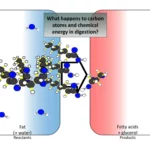As the global population continues to grow and demand for energy increases, the depletion of non-renewable resources becomes a pressing concern. These resources, such as fossil fuels, cannot be replenished at the rate at which we are consuming them. As a result, it is crucial to understand the importance of these resources and the need for sustainable practices.
The Building Blocks of Fossil Fuels: Carbon and the Carboniferous Period

Fossil fuels, the primary powerhouses of our modern world, owe their existence to a singular element: carbon. These energy-dense resources, formed over eons of geological processes, are essentially concentrated stores of carbon atoms, remnants of ancient life that once thrived on our planet.
The Carboniferous Period, a pivotal chapter in Earth’s history, played a crucial role in shaping the fossil fuels we rely on today. Spanning from about 360 to 300 million years ago, this era was characterized by lush vegetation and vast, swampy forests. These flourishing ecosystems, teeming with life, provided the raw material for the formation of fossil fuels.
As plants and animals perished, their remains sank into the depths of these swamps, accumulating over millennia. Over time, this organic matter was buried under layers of sediment, subjected to immense pressure and heat from the Earth’s interior. This transformative process, known as fossilization, gradually converted the buried plant and animal matter into the carbon-rich substances we now call fossil fuels.
Coal, for instance, the most abundant fossil fuel, is a testament to this remarkable transformation. Its formation involved the compression and carbonization of ancient plant matter over millions of years, resulting in a dense, carbon-rich rock that serves as a potent energy source.
Similarly, oil and natural gas, though formed from marine organisms rather than terrestrial plants, also share carbon as their primary building block. These fossil fuels, too, underwent a similar process of fossilization, trapped in underground reservoirs for millennia, their carbon molecules tightly packed, waiting to be released and harnessed for energy.
Carbon, therefore, stands as the cornerstone of fossil fuels, a legacy of the Carboniferous Period’s abundant life. The element’s versatility, its ability to form stable bonds with other elements, and its abundance in the Earth’s crust have all contributed to the formation of these valuable energy resources.
Decoding Coal’s Quality: The Carbonization Factor
Coal, the black or brownish rock we burn to create energy, is not a uniform substance. Instead, it exists in different grades or ranks, each with distinct characteristics and properties. These variations are primarily determined by the level of carbonization, a geological process that transforms plant matter into coal.
The carbonization process gradually removes oxygen, hydrogen, and other elements from the organic matter, leaving behind a denser, more carbon-rich material. The degree of carbonization, measured on a scale called the Carbon Rank Classification, determines the quality of coal.
At the lowest end of the scale lies lignite, a soft, brown coal with a low carbon content. Lignite burns with a smoky flame and produces a significant amount of ash. As the carbonization process intensifies, coal grades progress to subbituminous, bituminous, and anthracite. Each grade exhibits higher carbon content, becoming increasingly denser, harder, and more efficient as a fuel.
Anthracite, the highest-ranking coal, boasts a carbon content of up to 95%, making it the cleanest-burning and most energy-dense form of coal. However, its scarcity and higher cost compared to lower-ranking coals limit its widespread use.
The quality of coal is not merely a matter of energy output; it also influences the environmental impact of its combustion. Higher-ranking coals produce less ash and sulfur dioxide, reducing air pollution and acid rain formation.
Understanding the role of carbonization in determining coal quality is crucial for harnessing this fossil fuel efficiently and responsibly. By prioritizing the use of higher-ranking coals and adopting cleaner combustion technologies, we can minimize the environmental footprint of coal-fired power generation.
Natural Gas: The Methane-Rich Fossil Fuel
Natural gas, the invisible yet ubiquitous fuel that powers homes, industries, and even our vehicles, is primarily composed of methane, a simple yet potent hydrocarbon with the chemical formula CH4. This colorless, odorless gas, often referred to as CNG (Compressed Natural Gas) or LNG (Liquefied Natural Gas), is a major component of non-renewable resources, holding a significant share in the world’s energy mix.
Methane, the primary constituent of natural gas, is formed through a process known as methanogenesis, a complex biological process carried out by microorganisms in the absence of oxygen. These microorganisms, residing in deep underground reservoirs, break down organic matter, primarily plant and animal remains, into methane and carbon dioxide.
Over millions of years, this biogenic methane accumulates in porous rock formations, forming natural gas reservoirs. These reservoirs, often trapped beneath layers of impermeable rock, act as natural storage units for this valuable fossil fuel.
Natural gas is not only found in isolated reservoirs; it is also associated with coal deposits. As coal matures and undergoes intense heat and pressure, it releases methane as a byproduct. This methane, along with other gases, can migrate upwards and accumulate in coalbed methane reservoirs.
Another intriguing occurrence of methane is in the form of gas hydrates. These ice-like structures, found in deep ocean sediments and permafrost regions, trap methane molecules within their crystal lattices. Gas hydrates are considered a potential future energy source, holding vast amounts of methane in an unconventional form.
Natural gas, with its high energy content and relatively clean burning characteristics, has become a cornerstone of modern energy systems. Its versatility extends beyond power generation; it serves as a feedstock for various industrial processes and is increasingly finding applications in the transportation sector.
However, as with any fossil fuel, the extraction and utilization of natural gas raise environmental concerns. Methane, a potent greenhouse gas, can leak from natural gas infrastructure, contributing to climate change. Additionally, the hydraulic fracturing process, often employed to extract natural gas from shale formations, can pose environmental risks if not conducted responsibly.
Fossil Fuels: The Environmental Toll of Our Energy Reliance
Fossil fuels, the cornerstone of our modern energy systems, have come at a significant environmental cost. The extraction, processing, and combustion of these energy sources have unleashed a cascade of environmental consequences, threatening the delicate balance of our planet’s ecosystems and contributing to the pressing challenges of climate change and pollution.
At the heart of the environmental concerns surrounding fossil fuels lies the issue of greenhouse gas emissions. When fossil fuels are burned, they release carbon dioxide, methane, and nitrous oxide, potent greenhouse gases that trap heat in the Earth’s atmosphere, leading to global warming. The burning of fossil fuels is estimated to be the primary driver of global warming, accounting for around 65% of global greenhouse gas emissions.
The environmental impact of fossil fuels extends beyond greenhouse gas emissions. The mining and processing of these resources often lead to water pollution, as toxic chemicals and heavy metals from mining operations seep into waterways and contaminate groundwater. Soil contamination is another concern, as spills and leaks from fossil fuel infrastructure can introduce harmful substances into the soil, affecting agricultural productivity and posing health risks.
Fossil fuel extraction can also lead to habitat destruction, as vast areas of land are cleared to access coal, oil, and natural gas reserves. This disruption of ecosystems displaces wildlife, fragments habitats, and contributes to biodiversity loss.
The environmental consequences of fossil fuel use are not limited to local impacts. The burning of these fuels contributes to air pollution, causing respiratory illnesses and acid rain. The release of sulfur dioxide and nitrogen oxides from fossil fuel combustion leads to the formation of smog and acid rain, which can harm ecosystems and human health.
In addition to these direct environmental impacts, fossil fuel use also contributes to broader environmental challenges, such as water scarcity and resource depletion. The extraction and processing of fossil fuels require significant amounts of water, putting a strain on freshwater resources, especially in arid regions. Moreover, the finite nature of fossil fuels raises concerns about their long-term sustainability and the need for alternative energy sources.
Addressing the environmental toll of fossil fuels requires a multifaceted approach. Transitioning towards renewable energy sources, such as solar, wind, and geothermal, is crucial for reducing our reliance on fossil fuels and mitigating their environmental impacts. Implementing stricter environmental regulations and investing in cleaner technologies are also essential steps towards minimizing the environmental footprint of fossil fuel extraction and utilization.
The environmental consequences of fossil fuel use serve as a stark reminder of the delicate balance between energy needs and environmental sustainability. Moving towards a more sustainable energy future requires a collective effort to reduce our reliance on fossil fuels, embrace cleaner energy sources, and adopt responsible practices throughout the energy lifecycle.
Unleashing the Energy Potential: Combustion, the Key to Fossil Fuel Utilization
Fossil fuels, the remnants of ancient life, hold within them immense energy potential. This energy, stored in the form of chemical bonds between carbon atoms, remains dormant until a specific process, known as combustion, takes place.
Combustion, the rapid burning of a fuel in the presence of oxygen, is the key to unlocking the energy stored within fossil fuels. During combustion, the chemical bonds between carbon atoms in the fuel break, releasing heat and light. This release of energy is the fundamental principle behind the utilization of fossil fuels for various purposes.
When coal, oil, or natural gas is burned, the combustion process releases energy in the form of heat. This heat can be harnessed to generate electricity by converting it into mechanical energy, which then drives turbines to produce electricity. The heat generated from fossil fuel combustion can also be used directly for industrial purposes, such as steel production and glass manufacturing.
In addition to heat, combustion also produces light. This light, though often overlooked in the context of fossil fuel utilization, was the primary source of illumination during the pre-electricity era. Candles, oil lamps, and gas lamps all relied on the combustion of fossil fuels to produce light, revolutionizing human activities and extending our productive hours beyond daylight.
The energy released during fossil fuel combustion powers various aspects of modern life. It fuels our vehicles, providing transportation for people and goods. It heats our homes and businesses, ensuring comfort and productivity in various settings. It powers industrial processes, enabling the production of a wide range of goods and materials.
While combustion is the primary means of utilizing fossil fuels, other methods, such as gasification and liquefaction, are also employed to convert these resources into more versatile forms of energy. Gasification, for instance, converts fossil fuels into syngas, a mixture of hydrogen and carbon monoxide, which can be used as a fuel or feedstock for various industrial processes. Liquefaction, on the other hand, converts fossil fuels into liquid fuels, such as gasoline and diesel, making them more transportable and suitable for use in vehicles.
The combustion of fossil fuels has revolutionized human civilization, providing an abundant and relatively inexpensive source of energy that has driven economic growth and technological advancements. However, the reliance on fossil fuels has also raised concerns about environmental pollution and climate change. As we strive towards a more sustainable future, balancing the energy needs of our society with environmental responsibility remains a critical challenge.
The Post-War Fossil Fuel Boom: An Era of Unprecedented Energy Consumption

The aftermath of World War II ushered in an era of unprecedented fossil fuel consumption, a period marked by rapid economic growth, technological advancements, and a burgeoning global population. This surge in energy demand propelled the expansion of fossil fuel production and cemented their dominance as the world’s primary energy source.
The devastation of World War II left many nations in ruins, but also ignited a spirit of reconstruction and renewal. As economies rebounded and populations expanded, the demand for energy soared. Fossil fuels, with their abundance and relatively low cost, became the fuel of choice for this post-war resurgence.
Technological advancements played a significant role in this fossil fuel frenzy. The development of automobiles, airplanes, and industrial machinery fueled an insatiable appetite for energy. Fossil fuels provided the power to drive these machines, enabling the mass production of goods and the transformation of transportation systems.
The post-war population boom further amplified the demand for energy. As populations grew, so did the need for housing, heating, and electricity. Fossil fuels, with their ability to generate large amounts of energy from centralized sources, met these demands and became an integral part of modern life.
The fossil fuel frenzy of the post-war era transformed the global energy landscape. Countries like the United States and Saudi Arabia emerged as major fossil fuel producers, while the consumption of these resources soared across the world. This era of fossil fuel dominance laid the foundation for the modern energy system, with its reliance on oil, coal, and natural gas.
However, this period of unrestrained fossil fuel consumption also sowed the seeds of environmental challenges. The burning of fossil fuels releases greenhouse gases, contributing to climate change and air pollution. The extraction and processing of these resources have also caused significant environmental damage, including water pollution, soil contamination, and habitat destruction.
As the world grapples with the consequences of climate change and environmental degradation, the legacy of the post-war fossil fuel boom continues to shape the global energy discourse. While fossil fuels remain a significant source of energy, the need for transition towards cleaner and more sustainable energy sources has become increasingly urgent. The post-war fossil fuel frenzy serves as a reminder of the transformative power of energy, as well as the delicate balance between energy needs and environmental responsibility.
Oil: A Black Gold with Boundless Applications
Oil, the dark, viscous liquid that has fueled our modern world, is not merely an energy source; it’s a versatile substance with a vast array of applications that permeate nearly every aspect of our lives. From powering our vehicles to shaping our homes, oil’s transformative touch is undeniable.
At the heart of oil’s versatility lies its chemical composition, a complex mixture of hydrocarbons derived from the remains of ancient marine organisms. Over millions of years, these organic deposits were subjected to immense heat and pressure, transforming them into the precious resource we know today.
The most prominent application of oil is undoubtedly as a transportation fuel. Refined into gasoline, diesel, and other fuel products, oil powers our cars, trucks, airplanes, and ships, enabling mobility and connectivity across the globe. Oil’s high energy density and combustion properties make it an ideal fuel for powering these vehicles.
Beyond transportation, oil serves as a crucial raw material for a vast array of industries. The petrochemical industry, in particular, relies heavily on oil to produce plastics, the ubiquitous building blocks of modern life. From plastic bags and bottles to toys and medical devices, oil-derived plastics have become indispensable in our daily lives.
Oil’s reach extends further into the realm of chemicals, serving as a feedstock for the production of fertilizers, detergents, solvents, and pharmaceuticals. These products, essential for agriculture, hygiene, industrial processes, and healthcare, all have their roots in oil’s versatile nature.
Apart from its chemical applications, oil also plays a vital role in industrial lubrication. The refined components of oil, such as motor oil and hydraulic fluids, provide the necessary lubrication for machinery and engines, ensuring smooth operation and extending their lifespans.
Oil’s versatility extends beyond these primary applications. It finds use in the production of asphalt for roads, waxes for candles and cosmetics, and even crayons for children’s creative expression. The list goes on, showcasing the remarkable adaptability of this precious resource.
However, the immense benefits of oil come with environmental considerations. The extraction, processing, and combustion of oil can lead to pollution and climate change. As we strive towards a more sustainable future, finding cleaner alternatives to oil’s applications is a critical challenge.
Despite these environmental concerns, oil’s versatility and widespread use remain undeniable. It is a substance that has shaped our world, powering our industries, shaping our homes, and enabling our mobility. As we move towards a more sustainable future, oil’s legacy will undoubtedly continue to influence the way we live and interact with the world around us.
The Enigma of Remaining Resources: Uncertainty Amidst Finite Supplies
The exact amount of non-renewable resources remaining on Earth is a question that has perplexed scientists and policymakers for decades. Estimates vary widely, influenced by factors such as the rate of consumption, the accuracy of geological surveys, and the potential for undiscovered reserves.
Despite these uncertainties, one thing is clear: non-renewable resources are finite. They are formed over millions of years through geological processes and cannot be replenished at the rate at which we consume them. As our global population grows and energy demands escalate, the question of resource depletion becomes increasingly pressing.
The finite nature of non-renewable resources raises concerns about their long-term availability and sustainability. At current consumption rates, it is estimated that global coal reserves could last for about 130 years, while natural gas reserves could last for about 50 years. Oil reserves are projected to last for about 50 years, but this estimate is highly uncertain due to the uneven distribution of oil deposits and the challenges of extracting oil from unconventional sources.
The depletion of non-renewable resources poses significant economic and environmental challenges. As these resources become scarcer, their prices are likely to rise, impacting industries and consumers alike. Moreover, the extraction and utilization of non-renewable resources often lead to environmental damage, including water pollution, air pollution, and habitat destruction.
Given the finite nature of non-renewable resources and the associated challenges, transitioning towards renewable energy sources is crucial for ensuring a sustainable future. Renewable energy sources, such as solar, wind, and geothermal power, are abundant, clean, and have the potential to meet the world’s growing energy needs without depleting finite resources or causing significant environmental damage.
However, the transition to renewable energy requires concerted efforts, technological advancements, and substantial investments. Governments, businesses, and individuals all have a role to play in accelerating this transition and ensuring a sustainable energy future.
The question of remaining non-renewable resources is a complex one, shrouded in uncertainty. While we may not know the exact amount of resources left, the finite nature of these resources demands our attention and action. By embracing renewable energy sources and adopting sustainable practices, we can protect our planet’s resources and ensure a brighter future for generations to come.
The Patience of Nature: The Slow Formation of Non-Renewable Resources
Non-renewable resources, such as fossil fuels and minerals, are not just finite; they are also formed over vast timescales, a testament to the patience of nature’s geological processes. These resources, which power our modern world and underpin our industries, are the result of millions of years of transformation, a testament to the power of time and the intricate workings of the Earth’s systems.
Fossil fuels, the primary source of energy for our world, are formed from the remains of ancient organisms, primarily plants and marine life. These organisms, trapped in sediments over millions of years, underwent a process known as diagenesis, where they were subjected to increasing heat and pressure, gradually transforming into the coal, oil, and natural gas we rely on today.
Coal, the black or brownish rock that powers our industries, is the product of this slow transformation. Over millions of years, layers of plant matter accumulated in swamps and bogs, compressed under the weight of sediment and subjected to intense heat. This process gradually converted the organic matter into peat, a precursor to coal. Over time, further compression and heat transformed peat into lignite, bituminous coal, and eventually anthracite, the highest-rank coal.
Oil and natural gas, the liquid and gaseous forms of fossil fuels, also share a similar origin. These resources are formed from the remains of marine organisms that sank to the bottom of oceans, becoming trapped in sediments over millions of years. Under increasing heat and pressure, these organic deposits transformed into oil and natural gas, which migrated upwards through porous rock formations to form reservoirs.
The formation of minerals, the building blocks of our infrastructure and industries, also follows a slow and intricate process. Minerals are formed through various geological processes, including crystallization from molten rock, precipitation from hydrothermal fluids, and weathering of rocks and minerals. These processes, often involving the interaction of water, heat, and pressure, take place over vast timescales, shaping the Earth’s crust and creating the mineral deposits we exploit today.
The slow formation of non-renewable resources underscores the importance of responsible and sustainable practices. The finite nature of these resources, coupled with the immense time required for their formation, highlights the need to conserve these resources and seek alternative energy sources that do not deplete them. Embracing renewable energy sources, such as solar, wind, and geothermal power, is crucial for ensuring a sustainable future, one that does not rely on the consumption of resources formed over millions of years.
The formation of non-renewable resources serves as a reminder of the interconnectedness of our planet and the delicate balance between resource extraction, consumption, and sustainability. By understanding the slow and intricate processes that shape these resources, we can make informed decisions about their use and strive towards a future where our energy needs are met without compromising the planet’s resources for generations to come.
The Fossil Fuel Grip: Our Overdependence on a Finite Resource
Fossil fuels, the remnants of ancient life, hold a commanding grip on the world’s energy landscape. Despite growing concerns about environmental sustainability and energy security, these non-renewable resources still account for a staggering 80% of the total energy consumed worldwide, according to a 2023 report by the International Energy Agency. This overreliance on fossil fuels poses significant challenges for the future of our planet and our energy systems.
The dominance of fossil fuels is deeply entrenched in the global energy infrastructure. Our transportation systems, industries, and power grids have been built around the availability and affordability of these energy sources. Oil fuels our vehicles, coal powers our electricity plants, and natural gas heats our homes and businesses.
This dependence on fossil fuels has fueled economic growth, transformed societies, and enabled unprecedented connectivity across the globe. However, it has also come at a steep environmental cost. The burning of fossil fuels releases greenhouse gases, primarily carbon dioxide, which trap heat in the atmosphere, leading to global warming and climate change. Moreover, fossil fuel extraction and processing often lead to environmental damage, including water pollution, air pollution, and habitat destruction.
The environmental consequences of fossil fuel use extend beyond climate change. The extraction and processing of these resources often lead to water pollution, as toxic chemicals and heavy metals from mining operations seep into waterways and contaminate groundwater. Soil contamination is another concern, as spills and leaks from fossil fuel infrastructure can introduce harmful substances into the soil, affecting agricultural productivity and posing health risks.
The overreliance on fossil fuels also poses significant energy security challenges. The uneven distribution of these resources and the geopolitical tensions surrounding their extraction make global energy markets vulnerable to disruption and price volatility. This dependency on finite resources leaves us susceptible to supply shortages and price spikes, threatening economic stability and global cooperation.
Transitioning away from our overreliance on fossil fuels is an urgent and multifaceted challenge. It requires a global effort to invest in renewable energy sources, such as solar, wind, and geothermal power, which offer clean and sustainable alternatives. It also necessitates improvements in energy efficiency, reducing our overall energy consumption and minimizing our dependence on fossil fuels.
The transition to a more sustainable energy future will not be easy. It will require significant investments, technological advancements, and policy changes. However, the consequences of inaction are far more dire. The environmental and energy security challenges posed by our overreliance on fossil fuels demand a collective response, one that prioritizes sustainability, resilience, and the well-being of future generations.
Conclusion: Embracing Sustainable Practices and Shifting Towards Renewables
The depletion of non-renewable resources and their associated environmental consequences underscore the need for sustainable practices and a transition towards renewable energy sources. Renewable energy sources, such as solar, wind, and geothermal, are abundant, clean, and have the potential to meet the world’s growing energy needs. Investing in renewable energy technologies and promoting energy conservation are essential steps toward ensuring a sustainable future.
- Explore the 10 advantages of solar energy by delving into our article here.
- Discover the numerous 10 benefits of solar energy by clicking on this link: 10 benefits of solar energy.
- Interested in 10 examples of non-renewable energy? Find out more by visiting this page.
- Learn about 10 examples of non-renewable resources in our detailed article here.
- Want to know about 10 examples of non-renewable resources at home? Click here to explore further.
FAQ
Q1: What are non-renewable resources?
A1: Non-renewable resources are materials that are formed over long periods of time and cannot be replenished naturally within human timescales. They are the primary sources of energy for the world, including coal, oil, and natural gas. The use of fossil fuels has led to a number of environmental problems, including climate change, air pollution, and water pollution.
Q2: What is the main element in fossil fuels?
A2: The main element in fossil fuels is carbon. Fossil fuels are formed from the remains of dead organisms that were buried underground and subjected to heat and pressure over millions of years. During this process, the carbon from these organisms was transformed into the hydrocarbons found in fossil fuels.
Q3: What is the quality of coal given by?
A3: The quality of coal is given by the level of carbonization. Coal is ranked according to how much “carbonisation” it has gone through. The more carbonized the coal, the harder and more dense it is, and the more energy it can produce when burned.
Q4: What is natural gas and where does it come from?
A4: Natural gas is a fossil fuel that is composed primarily of methane. It is formed from the remains of dead organisms that were buried underground and subjected to heat and pressure over millions of years. Natural gas is often found in combination with oil, and it can also be found in its own deposits.
Q5: What is the biggest environmental damage caused by fossil fuels?
A5: The biggest environmental damage caused by fossil fuels is climate change. When fossil fuels are burned, they release greenhouse gases, such as carbon dioxide, into the atmosphere. These gases trap heat, which is causing the Earth’s temperature to rise. Climate change is already having a number of negative impacts on the planet, including rising sea levels, more extreme weather events, and changes in plant and animal life.
- Star Ring Trends: Etsy vs Amazon - March 28, 2025
- Boost Pollinator Habitats: Baby Blue Eyes Sustainable Farming Guide - March 28, 2025
- Protect Big Black Bears: Effective Conservation Strategies - March 28, 2025
















